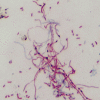Peripherally Inserted Central Catheter-Associated Nocardia nova Endocarditis in a Patient Receiving Intravenous Antibiotics for Chronic Lyme Disease
- PMID: 33728358
- PMCID: PMC7944348
- DOI: 10.1093/ofid/ofab041
Peripherally Inserted Central Catheter-Associated Nocardia nova Endocarditis in a Patient Receiving Intravenous Antibiotics for Chronic Lyme Disease
Abstract
Long-term antibiotics are not effective for the therapy of patients with persistent symptoms and a history of Lyme disease. However, some clinicians still prescribe these therapies. We present a case of peripherally inserted central catheter-associated Nocardia nova endocarditis in a patient who had been receiving intravenous antibiotics for the management of chronic Lyme disease. This case highlights an important risk associated with the unscientific use of indwelling peripheral catheters and intravenous antibiotics for the management of such patients.
Keywords: Nocardia nova endocarditis; Peripherally Inserted Central Catheter-Associated infection; Persistent symptoms and a diagnosis of Lyme Disease.
© The Author(s) 2021. Published by Oxford University Press on behalf of Infectious Diseases Society of America.
Figures
References
-
- Klempner MS, Hu LT, Evans J, et al. Two controlled trials of antibiotic treatment in patients with persistent symptoms and a history of Lyme disease. N Engl J Med 2001; 345:85–92. - PubMed
-
- Kaplan RF, Trevino RP, Johnson GM, et al. Cognitive function in post-treatment Lyme disease: do additional antibiotics help? Neurology 2003; 60:1916–22. - PubMed
-
- Berende A, ter Hofstede HJ, Vos FJ, et al. Randomized trial of longer-term therapy for symptoms attributed to Lyme disease. N Engl J Med 2016; 374:1209–20. - PubMed
-
- Krupp LB, Hyman LG, Grimson R, et al. Study and treatment of post Lyme disease (STOP-LD): a randomized double masked clinical trial. Neurology 2003; 60:1923–30. - PubMed
Publication types
Grants and funding
LinkOut - more resources
Full Text Sources
Other Literature Sources




